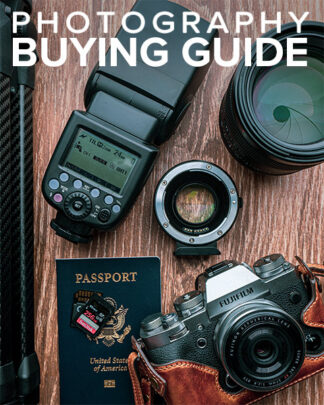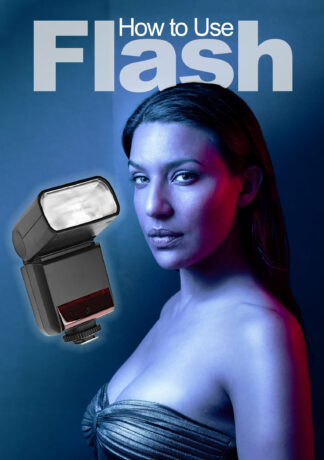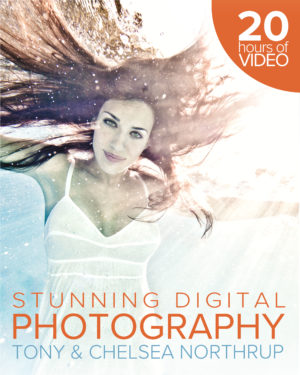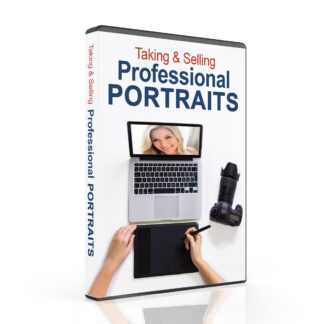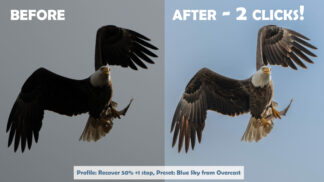Wedding photography doesn’t require a great deal of equipment. Start with a fast normal zoom (such as 24-70mm f/2.8, or your kit lens). The normal zoom will be useful for group shots and photos of indoor receptions in enclosed areas. The Tamron 24-70mm Di VC USD ($1,300) is an ideal choice. As a second lens, I like to use a telephoto zoom, such as a 70-200mm f/2.8. Follow the recommendations in the portrait photography section of this chapter. The telephoto range of the lens allows you to isolate subjects and simplify the background, allowing a clean composition even when people are crowding around the bride and groom. Using a lens with a low f/stop number (such as f/2.8) allows you to further simplify the composition by blurring the background. When shooting more than one person, however, be sure to use a high enough f/stop number to keep everyone’s face in focus. A powerful external flash is crucial. Outdoors, you’ll need it to fill in shadows and add a catch light to your subject’s eyes. I average 1,500 shots for a wedding, which is far more than any set of four batteries can provide. To give the flash more staying power and allow it to recycle faster, add an external battery pack. Lower-end flashes don’t support connecting an external battery pack, but all higher-end flashes will. The flash recommendations in the portrait sections of this chapter are perfect. If you have more than one camera body, even if it’s an older camera, bring it, attach a different zoom lens to it, and wear them both. This will allow you to quickly switch focal lengths without changing lenses. If you have enough memory, shoot RAW. Exposure can be very difficult because brides typically wear white, while grooms wear black. Shooting RAW gives you an extra stop or so of leeway, allowing you to recover burnt-out highlights and fill in black shadows on your computer. You won’t get the chance to re-shoot, so it’s best to be over-prepared. Bring extra batteries for both the flash and the camera. Bring extra memory cards. If you can, bring an extra camera and lens—even if it’s lower quality, it’s still better than nothing. Borrow the extra equipment from a friend if you need to. The wedding photographer’s uniform is black: black pants, black shirt. You can wear a photographer’s vest to carry extra batteries and lenses if you have one. You’re going to be moving more than anyone else in the wedding, so choose comfortable (but black) shoes. Ladies, wear pants, because you’ll find yourself climbing, leaning, and stretching to get the right angles. Most professional wedding photographers work in teams of two: a lead and an assistant. Your assistant should have a camera, too. If your assistant is less experienced, give him or her a wide-angle lens, put a bounce flash on it, and set it to automatic. It’s good to have two people shooting the ceremony simultaneously; however, only one person at a time should shoot the posed pictures, so that people always know where to look. Also, it helps if at least one of the photographers is a woman, so that the bride will be more comfortable getting ready in front of her. If you’re buying a DSLR specifically to shoot weddings, look for a camera with these characteristics:
- Great continuous autofocus. You’ll be shooting moving people when walking down the aisle and when on the dance floor. Therefore, a good autofocus system is critical. Almost any camera body will be good enough when using the center autofocusing point, so use continuous autofocus with the center autofocusing point on a basic camera, and shoot wide enough to allow you to crop for a nice composition. Cameras with advanced focus systems allow you to use many different focus points for reliable continuous autofocus, providing more flexible composition (at a much higher price).
- Low noise at high ISOs. Weddings often require you to shoot in low light, and adding flash could be unpleasant or distracting (especially during a church ceremony). Therefore, you often need to shoot with high ISOs, up to about ISO 6400.
- Quiet shutter. Many new cameras support a quite or silent shutter mode that will make you much more discreet, which is particularly important during the ceremony.
- High dynamic range. While less important than autofocus and high ISO, people at weddings tend to wear black and white. A camera with a high dynamic range will allow you to show detail in black tuxedos and white dresses. Be sure to shoot RAW!
If you plan to shoot weddings professionally, you’ll need a professional camera. Weddings are hard work; you’ll take hundreds of pictures, and you’ll need fast focusing in low light conditions. If your camera messes up and causes you to miss a shot, you can’t ever recreate it, and your clients will be crushed. Feel free to shoot a wedding with whichever camera you currently have, but be aware of the challenges you’ll face. Be sure to read Chapter 7 in Stunning Digital Photography. High-end cameras (typically priced over $2,500) are specifically designed for wedding photographers, and any of them will perform well. My specific recommendations for professional wedding photographers are, in order of preference and price from least to most:
- Nikon D810 ($3,300). The best overall camera in the world, the D810 has an excessive pixel count, incredible dynamic range, and matches or exceeds the 5D Mark III’s autofocus capabilities.
- Canon 5D Mark III ($3,400). Low noise, relatively light weight, and an amazing autofocus system make this the best Canon wedding photography camera.
- Nikon D4 ($6,000) or Canon 1DX ($6,800). The physical size of these beasts will impress many of your clients, and when you trip over a little kid (or drunk lady) while backing up to take a shot, this indestructible camera definitely won’t break. The autofocus systems beat everything else out there. Many people will still prefer the D810 or 5D Mark III, simply because it’s much lighter and still very capable.
Finally, I’ll make an unusual recommendation: get a film camera. It sounds crazy to go back to film, I know, but many wedding clients are impressed by a photographer who still uses film. You won’t want to do the entire wedding with film, but plan some portraits with a nice film camera. Film is romantic, whereas digital is quite cold. Many people grew up looking at the prints of their parents’ and grandparents’ weddings, and dreaming of the day their children would look through their own photo album. Plus, the negative is a true witness; it was there at the wedding, absorbing light that actually touched the happy family. Negatives are undeniably honest, never photoshopped, and survive hard drive crashes. 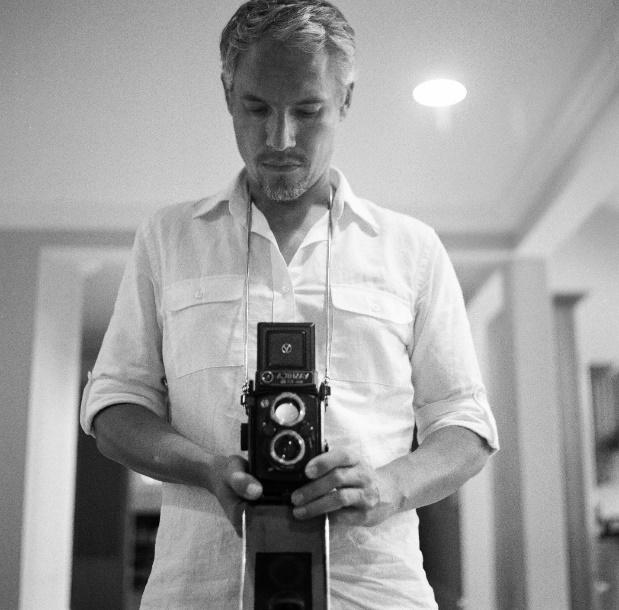 In short, a film camera can make you more marketable as a wedding photographer, even though it’s not an efficient addition to your workflow and it won’t produce more accurate or detailed images. You can buy 35mm film cameras, such as the Canon 1V or the Nikon F6, that fit your existing lenses. They function exactly like your modern DSLR, but nobody will even notice that you’re shooting with film. Instead, I suggest a more romantic film camera, the medium-format TLR (shown in the black-and-white self-portrait). Choose a model that shoots 120 film, use T-Max 400 black-and-white film, and then develop and scan at thedarkroom.com. Yashica, Mamiya, and Rolleiflex all make amazing TLRs, which you can find used for $100-$1000.
In short, a film camera can make you more marketable as a wedding photographer, even though it’s not an efficient addition to your workflow and it won’t produce more accurate or detailed images. You can buy 35mm film cameras, such as the Canon 1V or the Nikon F6, that fit your existing lenses. They function exactly like your modern DSLR, but nobody will even notice that you’re shooting with film. Instead, I suggest a more romantic film camera, the medium-format TLR (shown in the black-and-white self-portrait). Choose a model that shoots 120 film, use T-Max 400 black-and-white film, and then develop and scan at thedarkroom.com. Yashica, Mamiya, and Rolleiflex all make amazing TLRs, which you can find used for $100-$1000.

